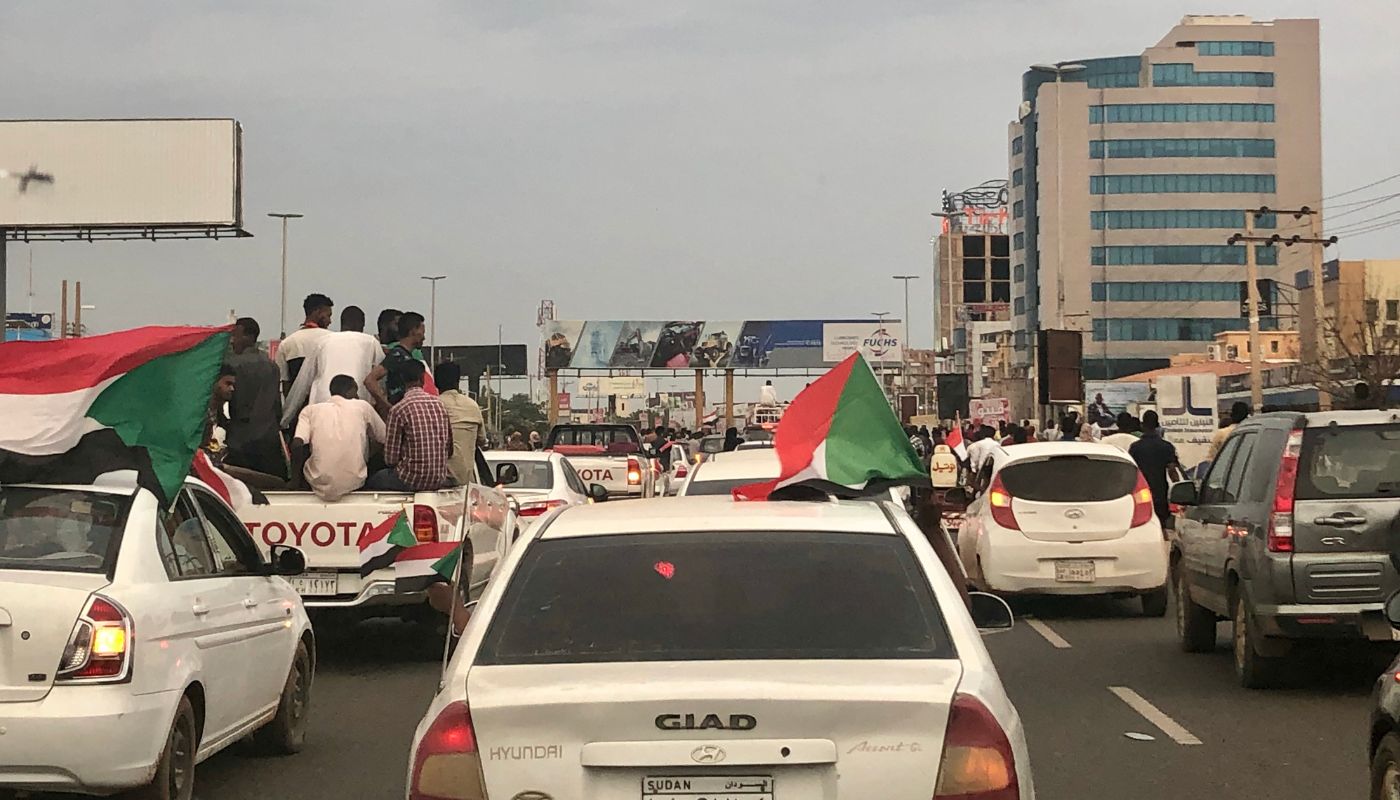
THE INVISIBLE CRISIS: SUDAN FROM AL-BASHIR TO TODAY
by IRENE PANOZZO
At dawn on June 3, 2019, as the country began its last day of fasting ahead of Eid al-Fitr, the end-of-Ramadan holiday that would begin that evening, Sudanese military forces attacked a sit-in in front of the army headquarters in the heart of Khartoum, which had been going on for almost two months. April and May are the hottest months in Sudan and the second month of the sit-in coincided with Ramadan, therefore with long hours of total fasting under the scorching Sudanese sun. Yet the pro-democracy demonstrators — especially young people, of both sexes — had remained in what since April 5 had become a sort of vast, colorful, peaceful encampment, a place of artistic creation and great solidarity not only among the participants in the sit-in, but also of part of the population of the capital, which continued to bring the demonstrators what they needed to move forward.
In the six years since that bloody last day of Ramadan, many things have happened in Sudan. Some positive and of great hope, others — many, too many others — of extreme violence and gravity. Scrolling through the Sudanese news, even just those of the days close to the recent anniversary of the sit-in massacre, is an exercise for strong hearts. A violent cholera epidemic is claiming victims in the state of Khartoum, the geographical, economic and political heart of the country, where the capital and its twin cities, Omdurman and Bahri, are located. According to data from ECHO, the EU’s humanitarian arm, in May there were 7000 officially registered cases, an increase of 400% compared to the previous month. While Médecins Sans Frontières, other international governmental and non-governmental organizations and what little remains of national health facilities try to cope with the exponential increase in cases, in the first days of June two serious attacks caused many civilian casualties in Darfur, the westernmost region of the country. In the first case, an air attack by the Sudanese armed forces (the national army, SAF according to the English acronym) on the market in the town of Al-Koma, in the state of North Darfur, left several dozen dead and many more injured. Two days after a humanitarian convoy of UNICEF and World Food Programme was hit by a drone, it is still unclear dropped by whom, which caused the burning of several food aid trucks and the death of 5 humanitarian workers. The convoy was traveling in the direction of el-Fasher, the capital of North Darfur. That is, the only one of the capitals of the five Darfur states that has remained in the hands of the SAF and which for more than a year has been under siege by the Rapid Support Forces (RSF), the paramilitary group that leads the front opposite that of the army in the all-out war that began on April 15, 2023.
SAF and RSF have long been two of the pillars of the security architecture of the regime of Omar al-Bashir, the general who seized power on June 30, 1989 in a military coup supported by the National Islamic Front, as the Sudanese Islamist party linked to the Egyptian Muslim Brotherhood was called at the time. During his decades in power, Bashir formalized the policy of “counter-insurgency in the economy” initiated by his predecessors to fight the civil war in the southern region of Sudan: arming and giving carte blanche for any crime and raiding to local militias recruited on a tribal basis, giving them air cover using the national air force, had become the official policy not only in what in 2011 would become independent South Sudan, but also in the civil war that began in Darfur in 2003. In the latter case, it was mainly Arab militias commonly known as janjawid (or “devils on horseback”), which in the mid-1910s Bashir himself had structured into a real paramilitary group, the RSF, to be brought to Khartoum as a Praetorian Guard to defend his regime from possible coups d’état.
When the Sudanese revolution began in mid-December 2018 — young, spontaneous, democratic, organized in the cities by neighborhood-based resistance committees to circumvent the regime’s repression — SAF and RSF had made a common front. First to defend Bashir, then to sacrifice him by deposing him on April 11, 2019, in response to the start of the sit-in. Faced with the insistence of the demonstrators who continued to demand that the military leave power to start a civil-led democratic transition, together they had responded with violence, on June 3, of the massacre on the banks of the Nile. But then, as the resistance continued, they agreed to negotiate with the representatives of the revolutionary civil front (professional groups, opposition political parties, trade unions, etc.) thus giving life, in September of that same year, to a transitional formula of cohabitation: a collective presidency, the Sovereign Council, composed of both military and civilian and a technocratic government led by a former United Nations economist, Abdallah Hamdok. In the Sovereign Council, the military had kept the leadership for themselves: the head of the army, General Abdelfattah al-Burhan, had become its president, the leader of the RSF, General Mohamed Hamdan Dagalo known as “Hemedti”, the vice president.
Only at that point had the protests stopped. To start again with force at the end of October 2021, when after two years of tiring cohabitation, Burhan and Hemedti ousted Prime Minister Hamdok, arrested several ministers and leaders of the civil front and effectively ended the democratic transition with a self-putsch. In the face of repeated attempts by the diplomatic community led by the UN and the African Union to get the various parties to dialogue to try to restart the transition, while the resistance committees continued their protests despite the violent repression of the military again alone in command, the many points of tension between the two military leaderships began to emerge with increasing clarity. Until leading, on the morning of April 15, 2023, to the outbreak of war. Hard-fought, for the first time in Sudan’s history, in the most central districts of the capital.
In just over two years of war, Sudan has become the largest and most serious humanitarian crisis in the world. Worse than Gaza and Ukraine. Out of an estimated population of about 50 million Sudanese, 12 million have been forced to leave their homes: about 8 million remaining within the national borders as internally displaced persons, another 4 finding refuge in neighboring countries. Including South Sudan and Chad, in turn among the poorest and most fragile countries in the world. According to some estimates, the number of deaths, perhaps still underestimated, would be around 150 thousand. In several areas, especially in those that have been the scene of the greatest clashes, famine has been declared, with millions of people at risk of starvation.
According to a recent analysis by Reuters, it will take several hundred billion dollars to rebuild the civilian infrastructure destroyed in these two years, especially in Khartoum and the twin cities. Assuming that the conflict ends soon. But there is no indication that the two warring sides have any intention of stopping. Or that their international backers — Egypt, Iran, Qatar, Turkey and, more paraly, Saudi Arabia for SAF, the United Arab Emirates and some countries bordering Sudan over which Abu Dhabi has a lot of influence for RSF — are ready to press for the weapons to stop. The front line continues to move. In March, the SAF recaptured Khartoum, which had remained in the hands of the RSF since the beginning of the conflict. Although there is no fighting in the capital for the moment, open clashes continue in the west, both in the Kordofan region and in Darfur. As the air strikes of SAF and those with drones of RSF continue, which in recent months have also targeted infrastructure in Port Sudan, the city on the Red Sea coast that has served as a temporary capital since the beginning of the conflict.
The first victims of the conflict, however, remain civilians. Both because many of the attacks target anyone, indiscriminately, and because in some areas of the country the current war has reactivated previous conflicts or tensions, even on an ethnic basis, leading to targeted massacres of certain groups. And finally because both SAF and RSF continue to have a common adversary: that large, varied, often very quarrelsome civil society that animated the revolution and which at this moment is weakened and scattered. But it survives and, among other things, animates those emergency response committees that since the beginning of the war have been trying to bring humanitarian aid where international organizations are prevented from going.
La lingua originale di questo articolo è l'Italiano.

